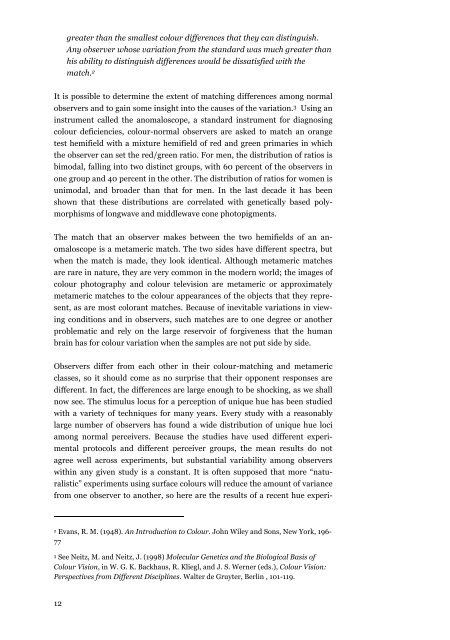Lightness and Brightness and Other Confusions
Lightness and Brightness and Other Confusions
Lightness and Brightness and Other Confusions
You also want an ePaper? Increase the reach of your titles
YUMPU automatically turns print PDFs into web optimized ePapers that Google loves.
greater than the smallest colour differences that they can distinguish.<br />
Any observer whose variation from the st<strong>and</strong>ard was much greater than<br />
his ability to distinguish differences would be dissatisfied with the<br />
match. 2<br />
It is possible to determine the extent of matching differences among normal<br />
observers <strong>and</strong> to gain some insight into the causes of the variation. 3 Using an<br />
instrument called the anomaloscope, a st<strong>and</strong>ard instrument for diagnosing<br />
colour deficiencies, colour-normal observers are asked to match an orange<br />
test hemifield with a mixture hemifield of red <strong>and</strong> green primaries in which<br />
the observer can set the red/green ratio. For men, the distribution of ratios is<br />
bimodal, falling into two distinct groups, with 60 percent of the observers in<br />
one group <strong>and</strong> 40 percent in the other. The distribution of ratios for women is<br />
unimodal, <strong>and</strong> broader than that for men. In the last decade it has been<br />
shown that these distributions are correlated with genetically based polymorphisms<br />
of longwave <strong>and</strong> middlewave cone photopigments.<br />
The match that an observer makes between the two hemifields of an anomaloscope<br />
is a metameric match. The two sides have different spectra, but<br />
when the match is made, they look identical. Although metameric matches<br />
are rare in nature, they are very common in the modern world; the images of<br />
colour photography <strong>and</strong> colour television are metameric or approximately<br />
metameric matches to the colour appearances of the objects that they represent,<br />
as are most colorant matches. Because of inevitable variations in viewing<br />
conditions <strong>and</strong> in observers, such matches are to one degree or another<br />
problematic <strong>and</strong> rely on the large reservoir of forgiveness that the human<br />
brain has for colour variation when the samples are not put side by side.<br />
Observers differ from each other in their colour-matching <strong>and</strong> metameric<br />
classes, so it should come as no surprise that their opponent responses are<br />
different. In fact, the differences are large enough to be shocking, as we shall<br />
now see. The stimulus locus for a perception of unique hue has been studied<br />
with a variety of techniques for many years. Every study with a reasonably<br />
large number of observers has found a wide distribution of unique hue loci<br />
among normal perceivers. Because the studies have used different experimental<br />
protocols <strong>and</strong> different perceiver groups, the mean results do not<br />
agree well across experiments, but substantial variability among observers<br />
within any given study is a constant. It is often supposed that more “naturalistic”<br />
experiments using surface colours will reduce the amount of variance<br />
from one observer to another, so here are the results of a recent hue experi-<br />
2<br />
Evans, R. M. (1948). An Introduction to Colour. John Wiley <strong>and</strong> Sons, New York, 196-<br />
77<br />
3<br />
See Neitz, M. <strong>and</strong> Neitz, J. (1998) Molecular Genetics <strong>and</strong> the Biological Basis of<br />
Colour Vision, in W. G. K. Backhaus, R. Kliegl, <strong>and</strong> J. S. Werner (eds.), Colour Vision:<br />
Perspectives from Different Disciplines. Walter de Gruyter, Berlin , 101-119.<br />
12
















